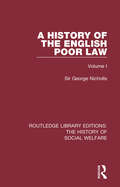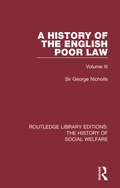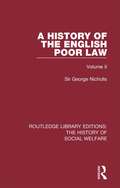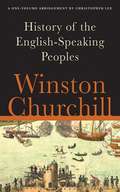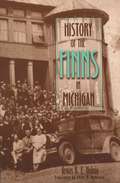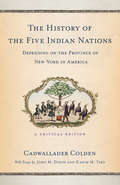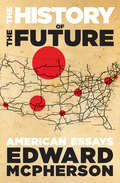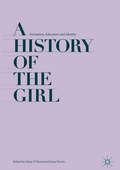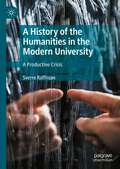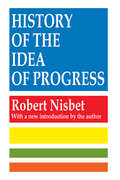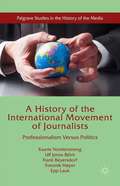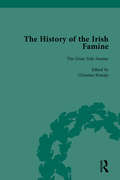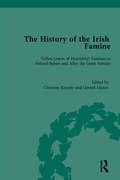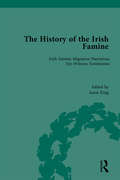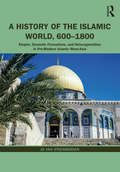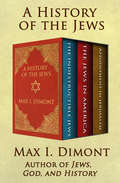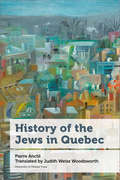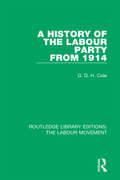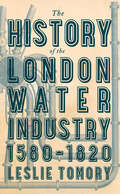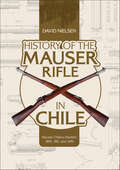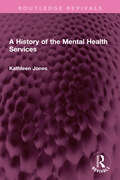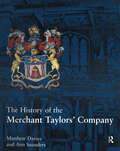- Table View
- List View
A History of the English Poor Law: Volume I (Routledge Library Editions: The History of Social Welfare #13)
by Sir George NichollsFirst published in 1854, this comprehensive work charts over three volumes the history of poor relief in England from the Saxon period through to the establishment of the Poor Law Amendment Act in 1834 and its reception. This edition, updated in 1898, also includes a biography of the author, Sir George Nicholls. Volume I examines poor relief from the Saxon period to the reign of Queen Anne. This set of books will be of interest to those studying the history of the British welfare state and social policy.
A History of the English Poor Law: Volume III (Routledge Library Editions: The History of Social Welfare #13)
by Sir George NichollsFirst published in 1854, this comprehensive work charts over three volumes the history of poor relief in England from the Saxon period through to the establishment of the Poor Law Amendment Act in 1834 and its reception. This edition, updated in 1898, also includes a biography of the author, Sir George Nicholls. Volume III examines poor relief from 1834 to 1898. This set of books will be of interest to those studying the history of the British welfare state and social policy.
A History of the English Poor Law: Volume II (Routledge Library Editions: The History of Social Welfare #13)
by Sir George NichollsFirst published in 1854, this comprehensive work charts over three volumes the history of poor relief in England from the Saxon period through to the establishment of the Poor Law Amendment Act in 1834 and its reception. This edition, updated in 1898, also includes a biography of the author, Sir George Nicholls. Volume I examines poor relief from the accession of George I to 1854. This set of books will be of interest to those studying the history of the British welfare state and social policy.
A History of the English-Speaking Peoples
by Winston ChurchillAn authoritative survey of the history of English-speaking peoples throughout the world combines intriguing, closely observed biographical profiles--of Alfred the Great, Victoria, Joan of Arc, Lincoln, and other notables--with an account of the key events and issues of the era. The narrative commences fifty-five years before the birth of Christ, when Julius Caesar famously "turned his gaze upon Britain,” and concludes in the year 1900. The beginnings of Parliament, the Church, and the monarchy are all analyzed alongside this comprehensive abridgment.
History of the Finns in Michigan
by Armas K. E. Holmio Ellen M. RyynanenMichigan's Upper Peninsula was a major destination for Finns during the peak years of migration in the nineteenth century and the early decades of the twentieth century. Several Upper Peninsula communities had large Finnish populations and Finnish churches, lodges, cooperative stores, and temperance societies. Ishpeming and Hancock, especially, were important nationally as Finnish cultural centers. Originally published in Finnish in 1967 by Armas K. E. Holmio, History of the Finns in Michigan, translated into English by Ellen M. Ryynanen, brings the story of the contribution of Finnish immigrants into the mainstream of Michigan history. Holmio combines firsthand experience and personal contact with the first generation of Finnish immigrants with research in Finnish-language sources to create an important and compelling story of an immigrant group and its role in the development of Michigan.
The History of the Five Indian Nations Depending on the Province of New-York in America: A Critical Edition
by Cadwallader Colden"How should we approach The History of the Five Indian Nations today? The book's information—rich as it is—should be critically interrogated and placed in social, political, and cultural context. The book reflects the outlook of a colonial British agent and, in a more general sense, of early modern European and Euro-American culture. Its claims of empirical objectivity should be historicized."—John M. Dixon, "Imperial Politics, Enlightenment Philosophy, and Transatlantic Print Culture""The History of the Five Indian Nations remains an invaluable font of information for understanding the Iroquois during the decades before European invaders began to pour into the Longhouse. Colden’s account of Iroquois military and diplomatic exploits is studded with fascinating details. It illuminates internal and external political dynamics as well as the extent and limits of European colonial power. Colden did not necessarily comprehend the cultural logic that guided Iroquois people, but he appreciated them as agents—remarkably audacious ones—in the affairs of all of eastern North America."—Karim M. Tiro, "Iroquois Ways of War and Peace"Cadwallader Colden’s History of the Five Indian Nations Depending on the Province of New-York in America, originally published in 1727 and revised in 1747, is one of the most important intellectual works published in eighteenth-century British America. Colden was among the most learned American men of his time, and his history of the Iroquois tribes makes fascinating reading. The author discusses the religion, manners, customs, laws, and forms of government of the confederacy of tribes composed of the Mohawks, Oneidas, Onondagas, Cayugas, and Senecas (and, later, the Tuscaroras), and gives accounts of battles, treaties, and trade with these Indians up to 1697.Since Cornell University Press first reprinted Colden’s History in 1958, the book has served as an invaluable resource for scholars and students interested in Iroquois history and culture, Enlightenment attitudes toward Native Americans, early American intellectual life, and Anglo-French imperial contests over North America. The new Critical Edition features materials not previously included, such as the 1747 introduction, which contains rich and detailed descriptions of Iroquois culture, government, economy, and society. New essays by John M. Dixon and Karim M. Tiro place The History of the Five Indian Nations Depending on the Province of New-York in America in historical and cultural context and provide a balanced introduction to the historic culture of the Iroquois, as well as their relationship to other Native people.
The History of the Future: American Essays
by Edward McphersonWhat does it mean to think about Dallas in relationship to Dallas? In The History of the Future, McPherson reexamines American places and the space between history, experience, and myth. Private streets, racism, and the St. Louis World’s Fair; fracking for oil and digging for dinosaurs in North Dakota boomtowns-Americana slides into apocalypse in these essays, revealing us to ourselves.
A History of the Girl: Formation, Education And Identity
by June Purvis Mary O'DowdThis book is centered on the history of the girl from the medieval period through to the early twenty-first century. Authored by an international team of scholars, the volume explores the transition from adolescent girlhood to young womanhood, the formation and education of girls in the home and in school, and paid work undertaken by girls in different parts of the world and at different times. It highlights the value of a comparative approach to the history of the girl, as the contributors point to shared attitudes to girlhood and the similarity of the experiences of girls in workplaces across the world. Contributions to the volume also emphasise the central role of girls in the global economy, from their participation in the textile industry in the eighteenth century, through to the migration of girls to urban centres in twentieth-century Africa and China.
The History of The Great Northern Railway: 1845 - 1902 (Routledge Revivals)
by Charles H. GrinlingPublished in 1903, this book provides a complete account of the origin and development of the Great Northern Railway Company from its inception to the year 1802, a period of around 60 years.
A History of the Humanities in the Modern University: A Productive Crisis
by Sverre RaffnsøeThis book challenges commonplace assertions that the humanities are presently undergoing a severe crisis as a result of a longstanding decline. Rather than hearkening to the widespread, reactive call for a last-ditch defense of the humanities under attack from an ungracious world, this book fundamentally reverses the perspective and makes a plea for a different, affirmative approach. It contends that the humanities have incessantly arrived at critical turning points since they were first constituted in a form that remains recognizable today and assumed a leading role in knowledge organization with the establishment of the modern university around 1800. Assuming a historical perspective, the monograph takes the human sciences back to their rightful place in the family tree of sciences and gives due recognition to their continuously decisive role in the production of new knowledge and the creation of new fields of knowledge. Situating the ongoing gemmation of the humanities in a broader context, this monograph also offers an encompassing introduction to the over-all development of knowledge in the last two hundred years.
History of the Idea of Progress
by Robert NisbetThe idea of progress from the Enlightenment to postmodernism is still very much with us. In intellectual discourse, journals, popular magazines, and radio and talk shows, the debate between those who are "progressivists" and those who are "declinists" is as spirited as it was in the late seventeenth century. In History of the Idea of Progress, Robert Nisbet traces the idea of progress from its origins in Greek, Roman, and medieval civilizations to modern times. It is a masterful frame of reference for understanding the present world.Nisbet asserts there are two fundamental building blocks necessary to Western doctrines of human advancement: the idea of growth, and the idea of necessity. He sees Christianity as a key element in both secular and spiritual evolution, for it conveys all the ingredients of the modern idea of progress: the advancement of the human race in time, a single time frame for all the peoples and epochs of the past and present, the conception of time as linear, and the envisagement of the future as having a Utopian end.In his new introduction, Nisbet shows why the idea of progress remains of critical importance to studies of social evolution and natural history. He provides a contemporary basis for many disciplines, including sociology, economics, philosophy, religion, politics, and science. History of the Idea of Progress continues to be a major resource for scholars in all these areas.
The History of the Incas (Joe R. and Teresa Lozano Long Series in Latin American and Latino Art and Culture)
by Pedro Sarmiento de GamboaThe History of the Incas may be the best description of Inca life and mythology to survive Spanish colonization of Peru. Pedro Sarmiento de Gamboa, a well-educated sea captain and cosmographer of the viceroyalty, wrote the document in Cuzco, the capital of the Inca Empire, just forty years after the arrival of the first Spaniards. The royal sponsorship of the work guaranteed Sarmiento direct access to the highest Spanish officials in Cuzco. It allowed him to summon influential Incas, especially those who had witnessed the fall of the Empire. Sarmiento also traveled widely and interviewed numerous local lords (curacas), as well as surviving members of the royal Inca families. Once completed, in an unprecedented effort to establish the authenticity of the work, Sarmiento’s manuscript was read, chapter by chapter, to forty-two indigenous authorities for commentary and correction. The scholars behind this new edition (the first to be published in English since 1907) went to similarly great lengths in pursuit of accuracy. Translators Brian Bauer and Vania Smith used an early transcript and, in some instances, the original document to create the text. Bauer and Jean-Jacques Decoster’s introduction lays bare the biases Sarmiento incorporated into his writing. It also theorizes what sources, in addition to his extensive interviews, Sarmiento relied upon to produce his history. Finally, more than sixty new illustrations enliven this historically invaluable document of life in the ancient Andes.
A History of the International Movement of Journalists: Professionalism Versus Politics (Palgrave Studies in the History of the Media)
by Kaarle Nordenstreng Frank Beyersdorf Svennik H�yer Epp Lauk Ulf BjrkThis study presents a general history of how journalism as an emerging profession became internationally organized over the past one hundred and twenty years, seen mainly through the associations founded to promote the interests of journalists around the world.
The History of the Irish Famine: Volume I: The Great Irish Famine
by Christine KinealyThe Great Irish Famine remains one of the most lethal famines in modern world history and a watershed moment in the development of modern Ireland – socially, politically, demographically and culturally. In the space of only four years, Ireland lost twenty-five per cent of its population as a consequence of starvation, disease and large-scale emigration. Certain aspects of the Famine remain contested and controversial, for example the issue of the British government’s culpability, proselytism, and the reception of emigrants. However, recent historiographical focus on this famine has overshadowed the impact of other periods of subsistence crisis, both before 1845 and after 1852. This first volume addresses the questions: when did the famine begin and end; to what extent is the British government after 1846 culpable for the suffering and mortality; how important was philanthropy in alleviating the distress; what was the role and responsibility of Irish elites; is the word famine appropriate given that Ireland continued to export large amounts of food.
The History of the Irish Famine: Fallen Leaves of Humanity: Famines in Ireland Before and After the Great Famine
by Christine Kinealy Gerard MoranThe Great Irish Famine remains one of the most lethal famines in modern world history and a watershed moment in the development of modern Ireland – socially, politically, demographically and culturally. In the space of only four years, Ireland lost twenty-five per cent of its population as a consequence of starvation, disease and large-scale emigration. Certain aspects of the Famine remain contested and controversial, for example the issue of the British government’s culpability, proselytism, and the reception of emigrants. However, recent historiographical focus on this famine has overshadowed the impact of other periods of subsistence crisis, both before 1845 and after 1852. This volume seeks to counterbalance the recent historiographical focus on the Great Irish Famine which has overshadowed the impact of other periods of subsistence crisis, both before 1845 and after 1852. As occurred during the Great Famine, they often resulted in increased levels of evictions, emigration, disease and death, although the scale was lower. While the Great Famine brought major economic, social and demographic changes, large areas of the country retained pre-famine structures with many communities continuing to have a subsistence existence and, consequently, regular crop failures and famines. These lesser known famines are examined in this volume along with the causes and why they did not achieve the scale of the Great Famine.
The History of the Irish Famine: Irish Famine Migration Narratives: Eyewitness Testimonies (Routledge Historical Resources)
by Jason KingThe Great Irish Famine remains one of the most lethal famines in modern world history and a watershed moment in the development of modern Ireland – socially, politically, demographically and culturally. In the space of only four years, Ireland lost twenty-five per cent of its population as a consequence of starvation, disease and large-scale emigration. Certain aspects of the Famine remain contested and controversial, for example the issue of the British government’s culpability, proselytism, and the reception of emigrants. However, recent historiographical focus on this famine has overshadowed the impact of other periods of subsistence crisis, both before 1845 and after 1852. This volume breaks new ground in bringing together foundational narratives of one of Europe and North America’s first refugee crises — making visible their impact in shaping perceptions, public opinion, and patterns of memorialization of Irish forced migration. It documents eyewitness impressions of suffering Irish emigrants, and raises questions about what literary conventions, mnemonic motifs, and popular images can be found in eyewitness accounts, press coverage, and foundational narratives of Famine Irish forced migration. These primary sources provide a model for understanding how representations of forced migration shape public opinion and policy.
The History of the Irish Famine: The Exodus: Emigration and the Great Irish Famine (Routledge Historical Resources)
by Gerard MoranThe Great Irish Famine remains one of the most lethal famines in modern world history and a watershed moment in the development of modern Ireland – socially, politically, demographically and culturally. In the space of only four years, Ireland lost twenty-five per cent of its population as a consequence of starvation, disease and large-scale emigration. Certain aspects of the Famine remain contested and controversial, for example the issue of the British government’s culpability, proselytism, and the reception of emigrants. However, recent historiographical focus on this famine has overshadowed the impact of other periods of subsistence crisis, both before 1845 and after 1852. This volume examines how the failure of the potato crop in the late 1840s led to the mass exodus of 2.1 million people between 1845 and 1855. They left for destinations as close as Britain and as far as the United States, Canada and Australia, and heralded an era of mass migration which saw another 4.5 million leave for foreign destinations over the next half-century. How they left, how they settled in the host countries and their experiences with the local populations are as wide and varied as the numbers who left and, using extensive primary sources, this volume analyses and assesses this in the context of the emigrants themselves and in the new countries they moved.
A History of the Islamic World, 600-1800: Empire, Dynastic Formations, and Heterogeneities in Pre-Modern Islamic West-Asia
by Jo Van SteenbergenA History of the Islamic World, 600–1800 supplies a fresh and unique survey of the formation of the Islamic world and the key developments that characterize this broad region’s history from late antiquity up to the beginning of the modern era. Containing two chronological parts and fourteen chapters, this impressive overview explains how different tides in Islamic history washed ashore diverse sets of leadership groups, multiple practices of power and authority, and dynamic imperial and dynastic discourses in a theocratic age. A text that transcends many of today’s popular stereotypes of the premodern Islamic past, the volume takes a holistically and theoretically informed approach for understanding, interpreting, and teaching premodern history of Islamic West-Asia. Jo Van Steenbergen identifies the Asian connectedness of the sociocultural landscapes between the Nile in the southwest to the Bosporus in the northwest, and the Oxus (Amu Darya) and Jaxartes (Syr Darya) in the northeast to the Indus in the southeast. This abundantly illustrated book also offers maps and dynastic tables, enabling students to gain an informed understanding of this broad region of the world. This book is an essential text for undergraduate classes on Islamic History, Medieval and Early Modern History, Middle East Studies, and Religious History.
A History of the Jews: The Indestructible Jews, The Jews in America, and Appointment in Jerusalem
by Max I. DimontThree books on Jewish heritage from the author of Jews, God, and History, &“the best popular history of the Jews written in the English language&” (Los Angeles Times). With over a million and a half copies sold, Jews, God and History introduced readers to &“the fascinating reasoning&” of acclaimed scholar Max I. Dimont&’s &“bright and unorthodox mind&” (San Francisco Sunday Examiner and Chronicle). In these three volumes, Dimont builds on the themes and insights presented in that seminal work, providing a rich and comprehensive portrait of the cultural and religious history of the Jewish people. The Indestructible Jews traces the four-thousand-year journey of the Jewish people from an ancient tribe with a simple faith to a global religion with adherents in every nation. Through countless expulsions and migrations, the great tragedy of the Holocaust and the joy of founding a homeland in Israel, this compelling history evokes a proud heritage while offering a hopeful vision of the future. The Jews in America offers an overview of Judaism in the United States from colonial times to twentieth-century Zionism. Dimont follows the various waves of immigration, recounts the cultural achievements of those who escaped oppression in their native lands, and discusses the attitudes of American Jews—both religious and secular—toward Israel. Appointment in Jerusalem explores the mystery surrounding the predictions Jesus made about his fate. Dimont re-creates the drama in three acts using his knowledge of the events recorded in the Bible. Thoughtful and fascinating, his account offers fresh insights into questions that have surrounded religion for centuries. Who was Jesus—the Christian messiah or a member of a Jewish sect?
History of the Jews in Quebec (Canadian Studies)
by Pierre AnctilThe presence of Jews in Quebec dates back four centuries. Quebec Jewry, in Montreal in particular, has evolved over time, thanks to successive waves of migration from different regions of the world. The Jews of Quebec belong to a unique society in North America, which they have worked to fashion. The dedication with which they have defended their rights and their extensive achievements in multiple sectors of activity have helped foster diversity in Quebec. This work recounts the different contributions Jews have made over the years, along with the cultural context that encouraged the emergence in Montreal of a Jewish community like no other in North America. This is the first overview of a history that began during the French Regime and continued, through many twists and turns, up to the turn of the twenty-first century.
A History of the Labour Party from 1914 (Routledge Library Editions: The Labour Movement #5)
by G. D. ColeFirst published in 1948, this book gives a full account of the development of the British Labour Party from its emergence as a national influence in the first world war to its return to power with an effective majority after the second world war. The study includes an epilogue which surveys the achievements of the party in the years after the 1945 election. This title will be of interest to scholars and students of history and politics.
The History of the London Water Industry, 1580–1820
by Leslie TomoryThis in-depth study explores the technological, cultural, and mercantile factors behind the infrastructure that transformed early modern London.Beginning in 1580, a number of competing London companies sold water directly to consumers through a large network of wooden mains in the expanding metropolis. This new water industry flourished throughout the 1600s, eventually expanding to serve tens of thousands of homes. By the late eighteenth century, more than 80 percent of the city’s houses had water connections—making London the best-served metropolis in the world while demonstrating that it was legally, commercially, and technologically possible to run an infrastructure network within the largest city on earth.Historian Leslie Tomory shows how an explosion of consumer demand and new technologies imported from the Continent spurred the rapid growth of London’s water industry. Meanwhile, several key local innovations reshaped the industry by enlarging the size of the supply network. By 1800, the success of London’s water industry made it a model for cities across Europe and beyond. It even inspired builders of other large-scale urban projects, including gas and sewage supply networks.
History of the Mauser Rifle in Chile: Mauser Chileno Modelo 1895, 1912, and 1935
by David NielsenThe acquisition history and the technical specifics of the Mauser rifles and carbines sold to Chile from 1895 to 1935
A History of the Mental Health Services: A Revised History Of The Mental Health Services - From The Early 18th Century To The 1990s (Routledge Revivals)
by Kathleen JonesFirst published in 1972, A History of the Mental Health Services is a revised and abridged version of both Lunacy, Law and Conscience and Mental Health and Social Policy, rewriting the material from the end of the Second World War to the passing of the Mental Health Act 1959, and adding a new section which runs from 1959 to the Social Services Act 1970. The story starts with the first legislative mention of the ‘furiously and dangerously mad’ as a class for whom some treatment should be provided, traces the development of reform and experiment in the nineteenth century, and the creation of the asylum system, and ends in the age of Goffman and Laing and Szasz with the virtual disappearance of the system. The book will be of interest to students of mental health, sociology, social policy, health policy and law.
The History of the Merchant Taylors' Company
by Matthew DaviesOne of the 'Great Twelve' livery companies of the City of London, the Merchant Taylors' Company has been in existence for some seven hundred years. This new history will chart the remarkable story of the Company and its members from its origins until the 1950s, encompassing the lives and achievements of men such as Sir Thomas White (founder of St John's College, Oxford) and the celebrated chronicler, John Stow, as well as the roles played by the Company in the City and beyond in different periods. As well as looking in detail at the internal life of the Company, the book will also focus on a number of important themes in the wider history of London. These include trade and industry, apprenticeship, the impact of religious change, the foundation of schools and other charities, and the government and politics of the City. In doing so, the book will contribute to an understanding of the aims and activities of the livery companies over the centuries, their ability to adapt to changing circumstances and their relevance in a modern world far removed from that in which they were first established. The History of the Merchant Taylors' Company will appeal to a wide range of people interested in the history of London. It is fully illustrated with more than seventy-five black and white and thirty colour illustrations.
